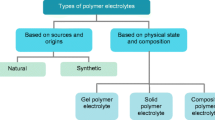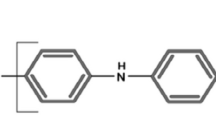Abstract
In this work, two quinoxline type monomers, 10,14-bis(4-octyl-2-thienyl)-dipyrido[3,2-a:2′,3′-c] [1, 2, 5] thiadiazolo[3,4-i] quinoxaline (OTPTP) and 10,14-bis(4-octyl-2-thienyl)-dibenzo[a, c][1,2,5]thiadiazolo [3,4-i] quinoxaline (OTBTP) were prepared, and the electrochromic features of their polymer films that were synthesized on the ITO glass surface by electrochemical polymerization were studied. The electronic characteristics of two different electron-withdrawing groups and their influences on the electrochemical polymerization of monomers and electrochromic performance of the obtained polymers were observed. The electronic performance of monomers illustrated that OTBTP can be polymerized in the lower potential range than OTPTP due to the stronger electron-withdrawing capability of the electron-withdrawing groups in OTPTP which contains two dipyridine units. The UV Visible NIR spectra analysis showed that both polymers, POTPTP and POTBTP, have one broad absorbance band in the region of 400 ~ 1600 nm at the neutral state. The electrochromic analysis revealed that the two polymer films exhibited reasonable optical contrasts in the infrared region of 1000 ~ 1600 nm with low response time (about 5 s) and low band gap.










Similar content being viewed by others
References
Lee JY, Han S-Y, Lim B, Nah Y-C (2019) A novel quinoxaline-based donor-acceptor type electrochromic polymer. J Ind Eng Chem 70:380–384. https://doi.org/10.1016/j.jiec.2018.10.039
Bhadra J, Alkareem A, Al-Thani N (2020) A review of advances in the preparation and application of polyaniline based thermoset blends and composites. J Polym Res 27(5):122. https://doi.org/10.1007/s10965-020-02052-1
Jiramitmongkon K, Chotsuwan C, Asawapirom U, Hirunsit P (2020) Cyclopentadithiophene and Diketo-pyrrolo-pyrrole fused rigid copolymer for high optical contrast electrochromic polymer. J Polym Res 27(1):17. https://doi.org/10.1007/s10965-019-1989-9
Chen X, Zhang J (2020) Blue-to-transmissive electrochromic poly(2,3-dimethyl-2,3-dihydrothieno[3,4-b][1,4]dioxine) (PEDOT-Me2) with improved optical contrast. J Solid State Electrochem 24(2):441–445. https://doi.org/10.1007/s10008-019-04343-0
Kim HN, Cho SM, Ah CS, Song J, Ryu H, Kim YH, Kim T-Y (2016) Electrochromic mirror using viologen-anchored nanoparticles. Mater Res Bull 82:16–21. https://doi.org/10.1016/j.materresbull.2016.03.010
Li S, Wang X, Hu R, Chen H, Li M, Wang J, Wang Y, Liu L, Lv F, Liang X-J, Wang S (2016) Near-infrared (NIR)-absorbing conjugated polymer dots as highly effective Photothermal materials for in vivo Cancer therapy. Chem Mater 28(23):8669–8675. https://doi.org/10.1021/acs.chemmater.6b03738
Liu S, Chen C, Li Y, Zhang H, Liu U, Wong S, Lam JWY, Ding D, Tang BZ (2019) Constitutional Isomerization Enables Ultrabright NIR-II AIEgen for Brain-Inflammation Imaging. Adv Funct Mater 30(7):1908125. https://doi.org/10.26434/chemrxiv.8684693.v1
Okamoto Y, Tanioka M, Muranaka A, Miyamoto K, Aoyama T, Ouyang X, Kamino S, Sawada D, Uchiyama M (2018) Stable Thiele’s hydrocarbon derivatives exhibiting near-infrared absorption/emission and two-step Electrochromism. J Am Chem Soc 140(51):17857–17861. https://doi.org/10.1021/jacs.8b11092
Wang B, Yuan H, Liu Z, Nie C, Liu L, Lv F, Wang Y, Wang S (2014) Cationic Oligo(p-phenylene vinylene) materials for combating drug resistance of Cancer cells by light manipulation. Adv Mater 26(34):5986–5990. https://doi.org/10.1002/adma.201402183
Dong H, Zhu H, Meng Q, Gong X, Hu W (2012) Organic photoresponse materials and devices. Chem Soc Rev 41(5):1754–1808. https://doi.org/10.1039/c1cs15205j
Maiorov VA (2019) Electrochromic glasses with separate regulation of transmission of visible light and near-infrared radiation (review). Opt Spectrosc 126(4):412–430. https://doi.org/10.1134/s0030400x19040143
Żmija J, Małachowski MJ (2011) New organic electrochromic materials and theirs applications. J Achiev Mater Manuf Eng 48(1):14–23
Kline WM, Lorenzini RG, Sotzing GA (2014) A review of organic electrochromic fabric devices. Color Technol 130(2):73–80. https://doi.org/10.1118/1.2167371
Zhang W, Zhu C, Huang Z, Gong C, Tang Q, Fu X (2019) Electrochromic 2,4,6-triphenyl-1,3,5-triazine based esters with electron donor-acceptor structure. Org Electron 67:302–310. https://doi.org/10.1016/j.orgel.2018.12.041
Ozyurt F, Durmus A, Gorkem Gunbas E, Toppare L (2010) A low-band gap conductive copolymer of bis-3-hexylthiophene substituted 4-tert-butylphenyl quinoxaline and 3,4-ethylenedioxythiophene. J Solid State Electrochem 14(2):279–283. https://doi.org/10.1007/s10008-008-0750-9
Pamuk M, Tirkeş S, Cihaner A, Algı F (2010) A new low-voltage-driven polymeric electrochromic. Polymer 51(1):62–68. https://doi.org/10.1016/j.polymer.2009.11.009
Esmer EN, Tarkuc S, Udum YA, Toppare L (2011) Near infrared electrochromic polymers based on phenazine moieties. Mater Chem and Phys 131(1–2):519–524. https://doi.org/10.1016/j.matchemphys.2011.10.014
Carbas BB, Kivrak A, Zora M, Önal AM (2012) Synthesis and electropolymerization of a new ion sensitive ethylenedioxy-substituted terthiophene monomer bearing a quinoxaline moiety. J Electroanal Chem 677-680:9–14. https://doi.org/10.1016/j.jelechem.2012.05.005
Cevher SC, Hizalan G, Temiz C, Udum YA, Toppare L, Cirpan A (2016) Effect of substituent groups on quinoxaline-based random copolymers on the optoelectronic and photovoltaic properties. Polymer 101:208–216. https://doi.org/10.1016/j.polymer.2016.08.076
Suganya S, Kim N, Jeong JY, Park JS (2017) Benzotriazole-based donor-acceptor type low band gap polymers with a siloxane-terminated side-chain for electrochromic applications. Polymer 116:226–232. https://doi.org/10.1016/j.polymer.2017.03.075
BaluAtar A, YunJeong J, HunHanJong S, Park S (2018) Efficient blue-to-transmissive electrochromic transitions of alkylated quinoxaline-thiophene based donor-acceptor type conjugated polymers. Polymer 153:95–102. https://doi.org/10.1016/j.polymer.2018.08.009
Mahmut M, Awut T, Nurulla I, Mijit M (2014) Synthesis and spectroelectrochemical investigation of low-bandgap polymer: integrated quinoxaline and benzimidazole in one electron acceptor unit. J Appl Polym Sci 131(19):40861. https://doi.org/10.1002/app.40861
Mahmut M, Awut T, Nurulla I, Mijit M (2014) Synthesis of two novel acenaphthyl-quinoxaline based low-band gap polymers and its electrochromic properties. J Polym Res 21(4):403. https://doi.org/10.1007/s10965-014-0403-x
Mahmut M, Awut T, Nurulla I (2015) Low band gap polymers synthesized by electrochemical polymerization for electrochromic devices. Chinese J Polym Sci 33(10):1442–1452. https://doi.org/10.1007/s10118-015-1698-8
Tarkuc S, Unver EK, Udum YA, Toppare L (2010) Multi-colored electrochromic polymer with enhanced optical contrast. Eur Polym J 46(11):2199–2205. https://doi.org/10.1016/j.eurpolymj.2010.08.002
Guo W, Engelman BJ, Haywood TL, Blok NB, Beaudoin DS, Obare SO (2011) Dual fluorescence and electrochemical detection of the organophosphorus pesticides—Ethion, malathion and fenthion. Talanta 87:276–283. https://doi.org/10.1016/j.talanta.2011.10.015
Ergang Wang LH, Wang Z, Hellström S, Mammo W, Zhang F, Inganäs O, Andersson MR (2010) Small Band Gap Polymers Synthesized via a Modified Nitration of 4,7-Dibromo-2,1,3-benzothiadiazole. Org Lett 12(20):4470–4473. https://doi.org/10.1021/ol1020724
Cai T, Zhou Y, Wang E, Hellström S, Zhang F, Xu S, Inganäs O, Andersson MR (2010) Low bandgap polymers synthesized by FeCl3 oxidative polymerization. Sol Energy Mater Sol Cells 94:1275–1281. https://doi.org/10.1016/j.solmat.2010.03.024
Zhang Y, Shi J, He X, Tu G (2016) All-thiophene-substituted N-heteroacene electron-donor materials for efficient organic solar cells. J Mater Chem A 4(35):13519–13524. https://doi.org/10.1039/c6ta03784d
Perzon E, Wang X, Admassie S, Ingana O, Anderson MR (2006) An alternating low band-gap polyfluorene for optoelectronic devices. Polymer 47:4261–4268. https://doi.org/10.1016/j.polymer.2006.03.110
Zhou S, An C, Stelzig T, Puniredd SR, Guo X, Pisula W, Baumgarten M (2015) Strengthening the acceptor properties of thiadiazoloquinoxalines via planarization. New J Chem 39(9):6765–6770. https://doi.org/10.1039/c5nj00517e
Yuen JD, Fan J, Seifter J, Lim B, Hufschmid R, Heeger AJ, Wudl F (2011) High performance weak donor–acceptor polymers in thin film transistors: effect of the acceptor on electronic properties, Ambipolar conductivity, mobility, and thermal stability. J Am Chem Soc 133(51):20799–20807. https://doi.org/10.1021/ja205566w
Baran D, Balan A, Celebi S, Meana Esteban B, Neugebauer H, Sariciftci NS, Toppare L (2010) Processable multipurpose conjugated polymer for Electrochromic and photovoltaic applications. Chem Mater 22(9):2978–2987. https://doi.org/10.1021/cm100372t
Eva Bundgaard FCK (2006) Low-band-gap conjugated polymers based on Thiophene, Benzothiadiazole, and Benzobis(thiadiazole). Macromolecules 39(8):2823–2831. https://doi.org/10.1021/ma052683e
Sun Y, Zhu G, Zhao X, Kang W, Li M, Zhang X, Yang H, Guo L, Lin B (2020) Solution-processable, hypercrosslinked polymer via post-crosslinking for electrochromic supercapacitor with outstanding electrochemical stability. Sol Energy Mater Sol Cells 215:110661. https://doi.org/10.1016/j.solmat.2020.110661
Yang S, Sun B, Liu Y, Zhu J, Song J, Hao Z, Zeng X, Zhao X, Shu Y, Chen J, Yi J, He J (2020) Effect of ITO target crystallinity on the properties of sputtering deposited ITO films. Ceram Int 46(5):6342–6350. https://doi.org/10.1016/j.ceramint.2019.11.110
Tamilavan V, Lee J, Kwon JH, Jang S, Shin I, Agneeswari R, Jung JH, Jin Y, Park SH (2019) Side-chain influences on the properties of benzodithiophene-alt-di(thiophen-2-yl)quinoxaline polymers for fullerene-free organic solar cells. Polymer 172:305–311. https://doi.org/10.1016/j.polymer.2019.04.011
Acknowledgements
This work was financially supported by the National Natural Science Foundation of China (No. 21662034) and Doctoral Initiation Fund of Xinjiang University (No.BS150226 and No. BS180218). We sincerely appreciate the support.
Author information
Authors and Affiliations
Corresponding author
Additional information
Publisher’s note
Springer Nature remains neutral with regard to jurisdictional claims in published maps and institutional affiliations.
Rights and permissions
About this article
Cite this article
Simayi, R., Murat, A., Imerhasan, M. et al. Low band gap polymers based on the electrochemical polymerization of Phenazine: studies on the color changing ability in near-infrared region. J Polym Res 27, 293 (2020). https://doi.org/10.1007/s10965-020-02266-3
Received:
Accepted:
Published:
DOI: https://doi.org/10.1007/s10965-020-02266-3




